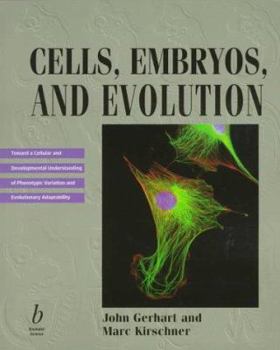Cells, Embryos and Evolution
Select Format
Select Condition 
Book Overview
In Cells, Embryos and Evolution the authors' ambition is to continue what Charles Darwin began: to understand not only the influence of selection on evolution but also the capacity of an organism to generate heritable variation upon which selection can act. Drawing on the theories derived from molecular, cellular and developmental biology in the past 20 years, John Gerhart and Marc Kirschner have begun to explain the origins of phenotypic variation...
Format:Paperback
Language:English
ISBN:0865425744
ISBN13:9780865425743
Release Date:June 1997
Publisher:Wiley
Length:656 Pages
Weight:3.01 lbs.
Dimensions:1.3" x 7.8" x 9.7"
Customer Reviews
5 ratings
The road to a new understanding of multicellular life
Published by Thriftbooks.com User , 22 years ago
John Gerhart and Marc Kirschner have boldly displayed a panorama of recent findings in biology which they methodically piece together into an entirely new understanding of the phylogenic and embryologic mechanisms of evolution. While aimed at the more sophisticated scientific reader (not an introductory text), their facility with modern experiments and exotic findings provide a thrilling ride from intracellular transduction mechanisms, through the differing phylogenetic strategies for embryogenesis (all phyla having been explosively formed in a brief "instant" after the first metazoans) and the secrets of evolvabilily making thier appearance in the embrogenetic regulatory mechanisms, not the structural proteins. For anyone who has ever found random mutation and selection an unsatisfying answer to evolution when all other biological processes are so exquisitely regulated (e.g. "Behavior and Evolution," Jean Piaget), Gerhart and Kirschner demonstrate that evolution is more of an extention of the generally "exploratory" property which is so central to life. This book is sure to spur a generation of new, productive thinking on the entire evolutionary paradigm. Perhaps when linked with work on structural stability in neural networks, a new macroscopic quantum formulation of biology may succeed a less informative and outdated stochastic formulation. [...]
Evolution of evolvability
Published by Thriftbooks.com User , 22 years ago
Although somewhat technical this book is highly recommended as an introduction to the issues of both developmental genetics and evolution both, and these in relation to the mystery of the Cambrian explosion in the controversies that surround that question. Molecular phylogenies give us few clues to the molecular changes that underlie species divergence. Students of evolution tend to rely on on theories of selection and population genetics as explanations for evolutionary change. But there are pitfalls here. For selection only provides a filter on the possible forms, screening the forms presented by development. Thus the study of embryological development becomes essential to seeing what is really happening. From this key idea the book proceeds to explore conservation and the evolution of evolvability, to use a phrase of Dawkins. The result is really quite a new subject altogether. The book ends with a question, has evolvability evolved and is it the result of clade selection? At this point I think we are leaving the realm of standard Darwinism into some new unknown terrain. Excellent book,and despite technical issues really quite clear, well presented.
Evolution via development
Published by Thriftbooks.com User , 24 years ago
The general reader who has already read some other references on development, will find this reference to be an easy to read yet detailed reference on evolutionary development which takes interesting conceptual viewpoints. The reference starts by pointing out the significant amount of cellular mechanisms conserved in all forms of life. The concept of 'contingency' is then developed, where it is considered to be the dependence of cellular activities on particular conditions, and its importance in metazoans. This leads to the concept of 'exploratory behavior', where it is considered to be responses of the organism to be more than can be explained by contingent mechanisms. For example, a version of the protozoan Stentor that is only .1% of the usual volume, yet its overall shape, the patterns of its cilia and gullet, are not changed. Plasticity observed in the nervous system is another such example. The concept of 'novelty' is then discussed, largely how new proteins have emerged. Multicellularity and differentiation are then considered, followed by the emergence of various body plans. The concept of developmental flexibility and robustness is considered as the development of the embryo is discussed. Limb buds and neural crest cells are then discussed as sources of evolutionary diversification of the vertebrate body plan. The final chapter of the reference considers the concept of 'evolvability', where it is considered to be the capability of organisms to produce nonlethal, phenotypic variations which natural selection can act upon, and thus allow evolution.
Destined to be a classic
Published by Thriftbooks.com User , 25 years ago
This book does a great job of unifying the many disparate threads of modern biology. This is one of the few books on biology written in this decade that may actually cause readers to see life from a new point of view. Destined to be a classic, right up there with D'Arcy Thompson's "Growth and Form" or Ptashne's book on phage lambda. Also this book is fun to read because there are tons of illustrations and also lots of interesting factoids about all sorts of weird organisms. If you are going to buy a book about biology, buy this one!
Excellent - but is afraid to take the next step.
Published by Thriftbooks.com User , 26 years ago
The authors of this book have taken a bold step toward a cellular view of evolution. But they shy from taking that final and necessary step of discarding the DNA based information model for a cellular one. Of course, doing this opens a pandora's box of Lamarkian thought. Still, considering the risks, the effort is more than commendable. Thank you for this book.





